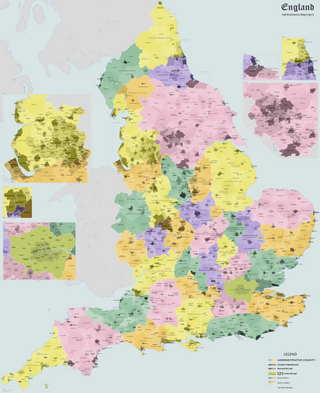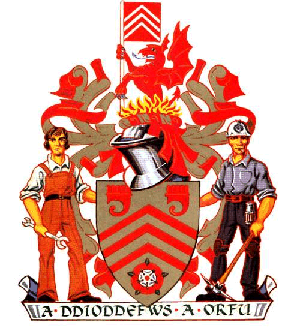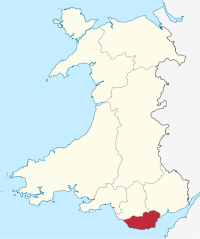
The Vale of Glamorgan, locally referred to as The Vale, is a county borough in the south-east of Wales. It borders Bridgend County Borough to the west, Cardiff to the east, Rhondda Cynon Taf to the north, and the Bristol Channel to the south. With an economy based largely on agriculture and chemicals, it is the southernmost unitary authority in Wales. Attractions include Barry Island Pleasure Park, the Barry Tourist Railway, Medieval wall paintings in St Cadoc's Church, Llancarfan, Porthkerry Park, St Donat's Castle, Cosmeston Lakes Country Park and Cosmeston Medieval Village. The largest town is Barry. Other towns include Penarth, Llantwit Major, and Cowbridge. There are many villages in the county borough.

The counties of England are divisions of England. Counties have been used as administrative areas in England since Anglo-Saxon times. There are two main legal definitions of the counties in modern usage: the 84 counties for the purposes of local government, and the 48 counties for the purposes of lieutenancy, also termed the ceremonial counties.

The preserved counties of Wales are the eight current areas used in Wales for the ceremonial purposes of lieutenancy and shrievalty. They are based on the counties which were used for local government and other purposes between 1974 and 1996. Each comprises one or more of the 22 single-tier principal areas which are used for administrative purposes.

County borough is a term introduced in 1889 in the United Kingdom of Great Britain and Ireland, to refer to a borough or a city independent of county council control, similar to the unitary authorities created since the 1990s. An equivalent term used in Scotland was a county of city. They were abolished by the Local Government Act 1972 in England and Wales, but continue in use for lieutenancy and shrievalty in Northern Ireland. In the Republic of Ireland they remain in existence but have been renamed cities under the provisions of the Local Government Act 2001. The Local Government (Wales) Act 1994 re-introduced the term for certain "principal areas" in Wales. Scotland did not have county boroughs but instead had counties of cities. These were abolished on 16 May 1975. All four Scottish cities of the time—Aberdeen, Dundee, Edinburgh, and Glasgow—were included in this category. There was an additional category of large burgh in the Scottish system, which were responsible for all services apart from police, education and fire.

Until 1974, Monmouthshire, also formerly known as the County of Monmouth, was an administrative county in the south-east of Wales, on the border with England, and later classed as one of the thirteen historic counties of Wales. Its area now corresponds approximately to the present principal areas of Monmouthshire, Blaenau Gwent, Newport and Torfaen, and those parts of Caerphilly and Cardiff east of the Rhymney River.

Mid Glamorgan is a preserved county of Wales. From 1974 until 1996 it was also an administrative county with a county council.

West Glamorgan is a former administrative county in South Wales. It is now a preserved county.

The Local Government Act 1972 is an act of the Parliament of the United Kingdom that reformed local government in England and Wales on 1 April 1974. It was one of the most significant Acts of Parliament to be passed by the Heath Government of 1970–74.

The Borough of Ogwr was one of six districts of Mid Glamorgan in Wales, which existed from 1974 to 1996.

Rhondda was a local government district in the geographical area of the Rhondda Valley, south Wales, from 1877 until 1996, with various statuses through its history.

The Lieutenancies Act 1997 is an Act of Parliament in the United Kingdom that defines areas that lord-lieutenants are appointed to in Great Britain. It came into force on 1 July 1997.

Cardiff Council, formally the County Council of the City and County of Cardiff is the governing body for Cardiff, one of the principal areas of Wales. The principal area and its council were established in 1996 to replace the previous Cardiff City Council which had been a lower-tier authority within South Glamorgan. Cardiff Council consists of 79 councillors, representing 28 electoral wards.

The District of Swansea was a local government district with city status in West Glamorgan, Wales from 1974 to 1996.

The Cardiff district was one of the two local government districts of South Glamorgan in Wales from 1974 to 1996.

Gwent is a preserved county and former local government county in southeast Wales. A county of Gwent was formed on 1 April 1974, under the Local Government Act 1972; it was named after the ancient Kingdom of Gwent. The authority was a successor to both the administrative county of Monmouthshire and the county borough of Newport.

Cardiff City Council was the local government district authority that administered the city of Cardiff, capital of Wales, from 1974 until 1996. The district council replaced the pre-1974 county borough council. It was succeeded in 1996 by Cardiff Council.
The history of local government in Wales in a recognisably modern form emerged during the late 19th century. Administrative counties and county boroughs were first established in Wales in 1889. Urban and rural districts were formed in 1894. These were replaced in 1974 by a two-tier authority system across the country comprising eight counties and, within them, thirty-seven districts. This system was itself replaced by the introduction of 22 single-tier authorities in 1996.

South Glamorgan County Council was the local government authority that administered the county of South Glamorgan, Wales from its creation in 1974 until its abolition in 1996.

Mid Glamorgan County Council was the upper-tier authority for the Welsh county of Mid Glamorgan between its creation in 1974 and its abolition in 1996.
The Vale of Glamorgan Borough Council was the local authority for the Vale of Glamorgan in South Glamorgan, Wales, created in 1974 and reconstituted in 1996 as the Vale of Glamorgan Council unitary authority. It was a second tier district authority, with South Glamorgan County Council providing county-level services to the area.


















